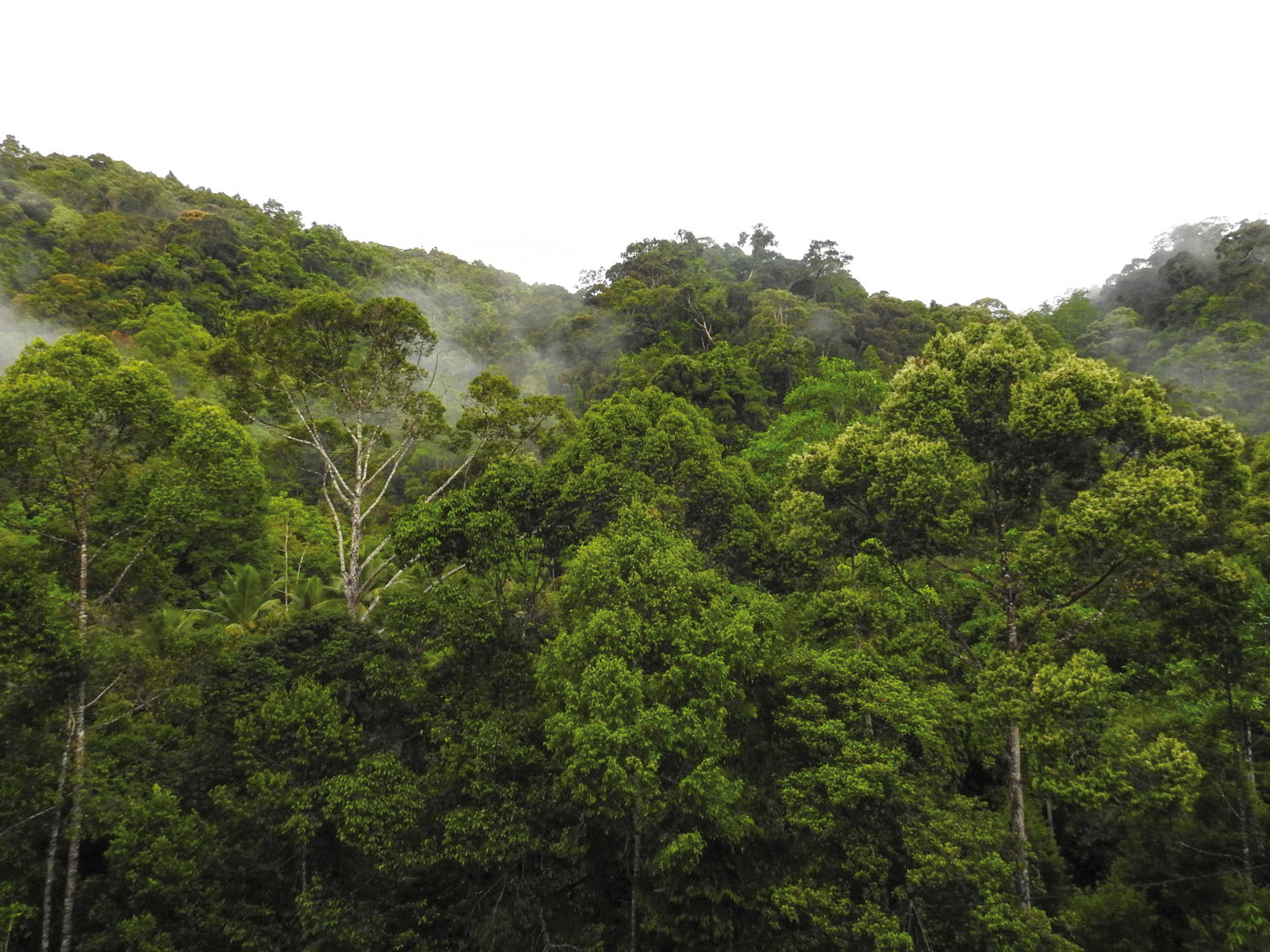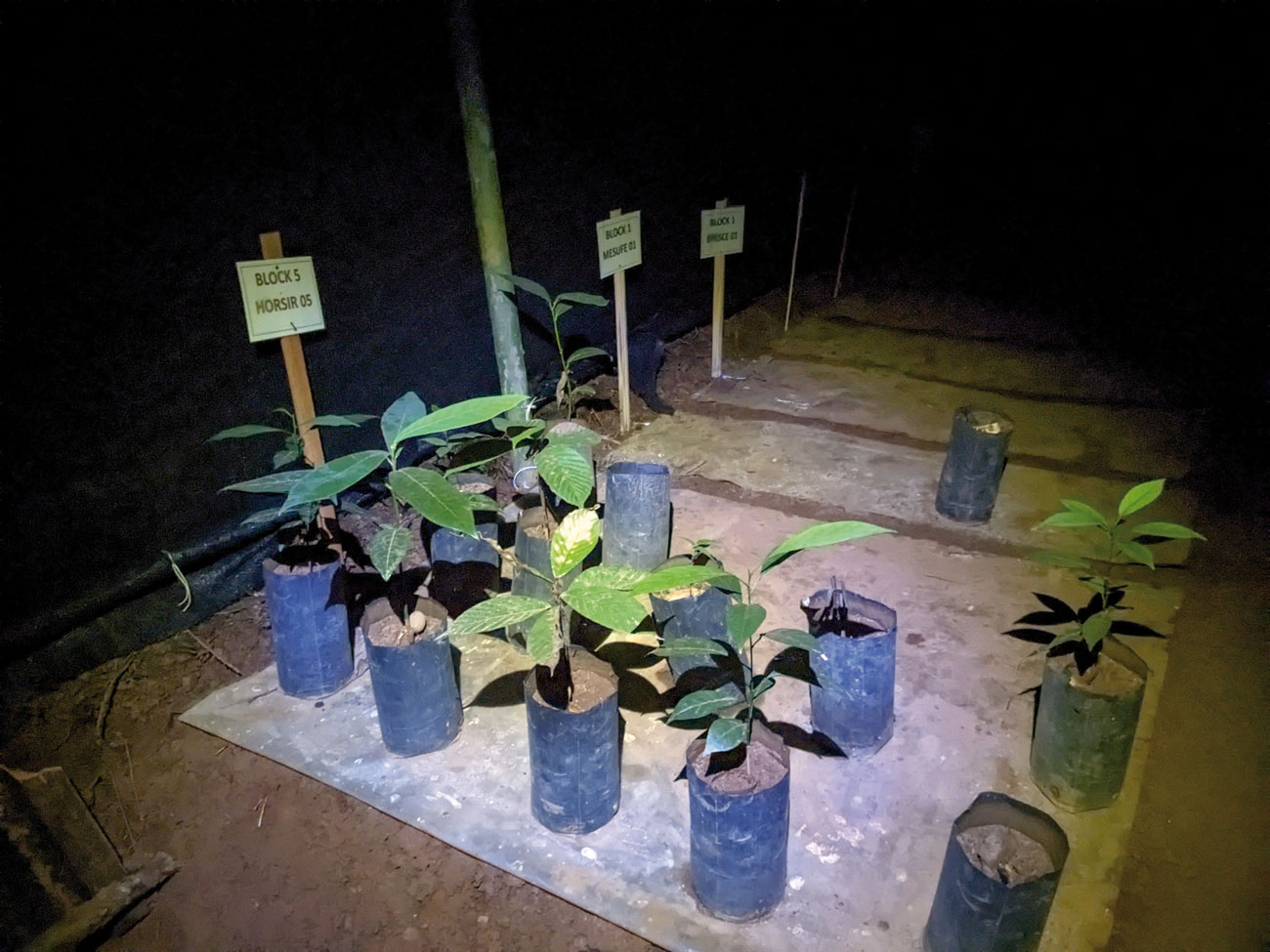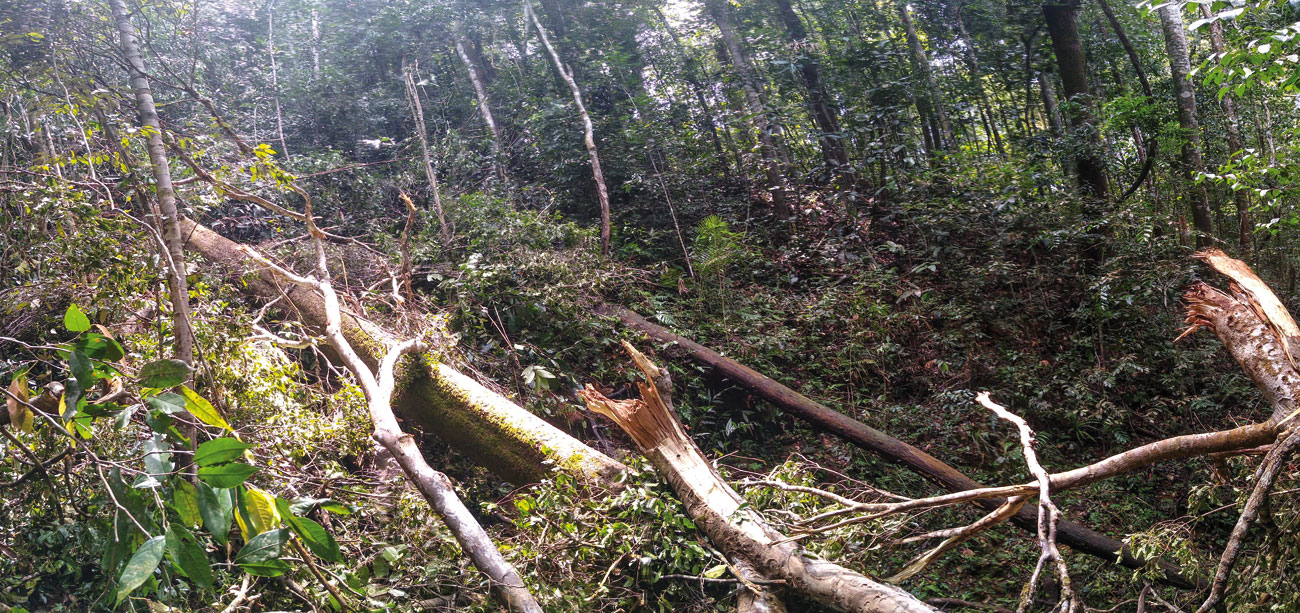Why Are Mixed Dipterocarp Forests... Mixed?
First published in Sanctuary Asia,
Vol. 44
No. 2,
February 2024
By Akshay Surendra
In Search of Dipterocarps
I had just been let out of quarantine in 2021. The very next day, my colleague Upul Shantha and I set off to explore the Sinharaja rainforest in southwest Sri Lanka. I was in a foreign country but there was a vague sense of familiarity everywhere. I could hear the same gurgling of Yellow-browed Bulbuls as I would in the Western Ghats, I could smell the same faint whiff of jackfruit near houses, and the trees – they were like old friends in a foreign land.
“Is this Symplocos?” I asked, stretching out a soft leathery leaf with toothed edges between my fingers and pointing it at Upul. “Yes. Symplocos cochinchinensis. The Sinhala name is bombu,” he replied. The same species as India! In fact, the shabby forest around me didn’t look too different from the spot in Periyar where I had first seen this scrubby species with my classmates. Over the next year and a half, field work in Sri Lanka’s forests would be filled with such deja vu moments – a daily appreciation that biogeography knows no political boundary. And an appreciation that India is such a big, biodiverse country – truly a sub-continent.

Multiple species of Shorea can be found in these dense jungles, each flowering at a different time to maximise repoduction success. Photo: Akshay Surendra.
The forest became darker as we walked beneath an arch that read ‘Sinharaja Man and Biosphere Reserve’. Beside the trail, a tree with shiny oval leaves caught my eye. “Upul, is this a species of Diospyros?” I asked. I was thinking of kala lakdi, or Diospyros kurzii, from the Andaman Islands. It had the same smooth shiny surface, those same petite leaves that looked like performance-stickers from primary school, and the same faintly sympodial (bifurcating branching) growth that made the tree look posh. “No no,” Upul said, grinning. “That is Shorea affinis of the dipterocarp family. The Sinhala name is yakahaalu.”
So, this was the one! A species of Shorea from the section Doona from the Dipterocarpaceae family. Trees from this family – fondly called dipterocarps – have specialised fungal partners in their roots called ectomycorrhizae. These root fungi are believed to give their hosts the ‘superpower’ of talking to each other and outcompete other species. However, dipterocarps weren’t taking over the forest, but instead, they were letting trees without this superpower live alongside them. My job was to find out why.
The Holy Grail
How do so many kinds of trees that rely on just water, nutrients and light, live together?
This question is pretty much the holy grail of plant ecology. Are trees truly cooperating with each other to share light, nutrients and water, like Good Samaritans? And if that’s true, was Darwin incorrect? Is the gene even selfish? But before you go too far: no, Darwin was, and is, correct. Trees seemingly rely on the same three things – water, light and nutrients – but if you look closely, you’ll find that individual species are slightly different from each other. Some are better at intercepting light, others require more water, some can survive in soils with almost no nutrients, and so on. There are trees that are “nimble”, that “live fast and die young”, while other species grow slowly but live for a really long time. All these differences help trees find their own little corners in the forest, and survive. But all species? In a forest with hundreds of different species, you would be hard-pressed to find hundreds of such differences to justify their continued existence. For example, why isn’t Palaquium ravii simply outcompeting Palaquium ellipticum into extinction?
Enter plant enemies. In 1970, a clever young fellow named Daniel Janzen – now a retired professor, who has probably done more to conserve Costa Rica’s forests and wildlife than anyone else – came up with an idea. What if plants play host to specialised enemies, say a kind of beetle or some deadly fungi invisible to the naked eye, and these enemies kept their host plants (and little else) in check? When host plants became too common, these beetles and fungi would become common too, and with nowhere to hide, these plants would die out. There would come a point where these plants would be too rare, where these beetles and fungi would find a hard time finding their ‘prey’, and they too would die out. Slowly, the few plants that remain would peek out from behind the bushes and gather strength, increasing in numbers, and this cycle would repeat. This idea is known as the Janzen-Connell hypothesis (another clever fellow called Joseph Connell had a similar idea; Connell passed away in 2020 at the age of 96, with this and many more interesting ideas to his name). Over the last 50 years, we understand that at least some version of this Janzen-Connell hypothesis is true.
But I wasn’t interested in plant enemies alone; I wanted to understand plant ‘friends’ as well. Plants have many friends – birds that disperse their seeds, bees and thrips that pollinate their flowers, and fungi within their leaves that mostly (but not always) help plants. But by far the most significant friend that helps plants with their daily lives, are symbiotic root fungi. Most trees have root fungi but some species, such as our dipterocarp friends, have a special kind called ectomycorrhiza (ecto = outside, myco = fungus, rrhiza = root; fungi that live outside but in between root cells of their host plants). And these ectomycorrhizae are powerful friends to have.

The author’s experiment, where seedlings of dipterocarp trees (and others) were plonked in soils with and without enemies and friends. Photo: Akshay Surendra.
Can Powerful Friends Cancel Out Enemies?
Silly as it sounds, answering such a question is really difficult. But I had to try. I stepped back to ask – do these friends with benefits even matter? These ectomycorrhizae, are they exchanging carbon? Then their friendship isn’t free! Plants exchange carbon (and a lot of it) for so little benefit in the form of nutrients, that shouldn’t plant enemies always have the final word? Or are these connections so important that if you wait long enough, you’ll see these powerful friends help their host dipterocarps take over the forests?
The first step to answering these riddles was to check if these dipterocarps were indeed special, using an experiment. We plonked baby dipterocarps into soil with both enemies and friends, and in comparison, we also grew them in soils with neither enemies nor friends. Would enemies win over friends and slowly kill the baby tree, or would friends win over enemies and help the baby do well? That was something we wanted to check.
The next step was to check, if what we found in the first step, really mattered. In the real world, nobody would be moving baby trees or soils anywhere, and there would be all kinds of differences found in nature. For this step, we built on the work of previous Sri Lankan researchers who had carefully studied one patch of forest intensely, since the 1990s. In this patch, we tagged baby trees with plastic rings, identified them, measured their heights and walked away.
A year later, we returned to check on them – were they alive? If so, were they growing at all? And who are the new baby trees around them? A year after that, we repeated the same thing. We wanted to check if dipterocarp babies, when they were growing in soils with a lot of enemies and friends (in this case, lots of adult dipterocarps nearby), were doing better than when they were growing with neither enemies nor friends around (little or no adult dipterocarps nearby).

When trees fall, they make gaps that break an otherwise dark understory, allowing saplings of light-demanding species to grow. Photo: Akshay Surendra.
And what did we find? Dipterocarps do seem to be doing better when their specialised enemies and friends were around but only in the real world, in the forest. Here, there are all kinds of things going on: water accumulates in some areas but not in others, the underlying rock changes making it easy or difficult for trees to put down roots, and there are of course, enemies and friends in the air. Maybe it was all these forces acting in unison that helped make it happen, something our experiment could not recreate. But this only adds further intrigue – why aren’t these dipterocarps taking over the forest?
Studying forests and wildlife is always messy and complicated, but that is the beauty of it. Who knows, maybe tomorrow someone might find the opposite is true, that enemies do matter more than friends for dipterocarps!
The Conservation Challenge
Sri Lanka’s Sinharaja Rainforest Complex is one of the best protected forests of South Asia. Dipterocarps, their friends, their enemies and their neighbouring trees are all well protected, alongside all the fauna inhabiting them. But in the next decade or so, economic forces may have the last word because Sri Lanka is going through its worst economic crisis in living memory. People still cook a little extra rice to feed wild Blue Magpies and avoid cutting old-growth trees for firewood, but for how long? Unprotected forest fragments around the Sinharaja Rainforest Complex may be lost too, as people, rich and poor, return to regain wealth from the land at nature’s cost.
Over the next century, what happens to these forests might depend on the climate. Sri Lankan rainforests are unique, like endemic wildlife atop a mountain. Over millennia, the Western Ghats have become periodically wetter or drier, and in those dry times, many kinds of trees have gone extinct in India. But Sri Lanka has always been wet enough for these sensitive species to persist, such as Schumacheria or Hortonia. Yet these Sri Lankan wet zone trees are trapped, restricted to a small south-west quadrant of the island, like the top of a mountain. Will these dipterocarps and their forests withstand changes in climate as they have for millions of years, or will we finally push this ancient forest into oblivion? Only time will tell.
Akshay Surendra A community ecologist interested in forests and birds, he is an alumnus of the NCBS Programme in Bengaluru. He is currently writing his Ph.D. dissertation in forest ecology at the Yale School of the Environment, USA.




